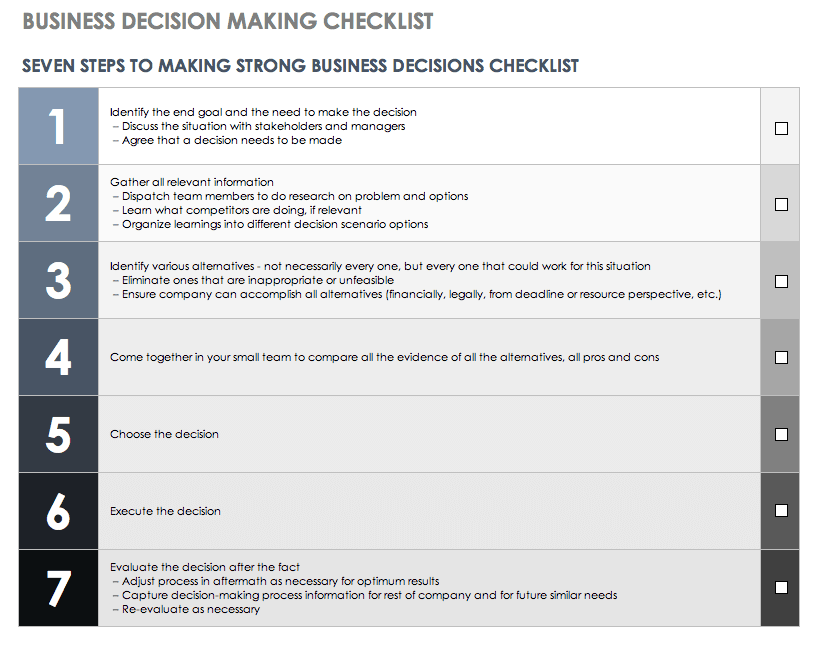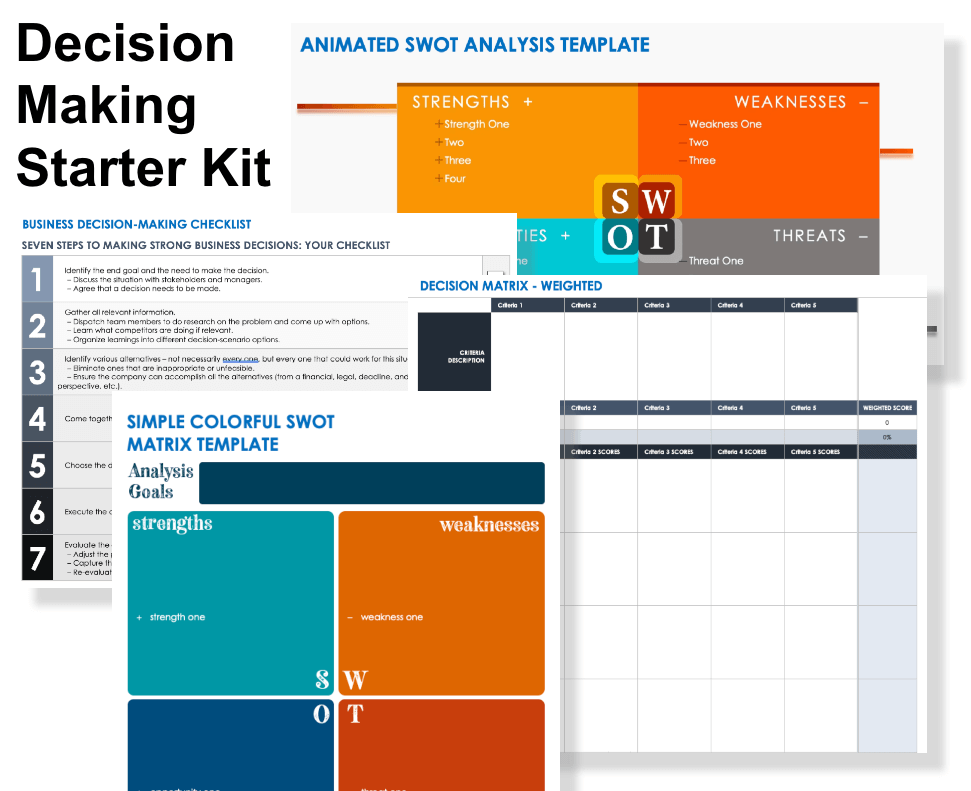What Is a Decision-Making Process?
A decision-making process is a set of steps used to make an informed choice between two or more alternatives. These processes are often used to make business decisions, such as where to allocate resources or how to prioritize projects.
What Is the First Step in Any Decision-Making Process?
The first step in any decision-making process is to determine whether or not a decision needs to be made. Outline why this decision is critical for your business goals or objectives, and ensure that you can explain your reasoning.
It might sound obvious, but fast-moving organizations often overlook this step. A decision or goal can't be made in a vacuum, and it is often a waste of time and resources to make a decision that does not align with a business need. Consider whether or not the time you spend doing the research to make a decision will be time well spent in the long run.
Types of Decision-Making Processes
There are three main types of decision-making processes: rational, intuitive, and creative. Rational decision-making processes are based on data, intuitive ones are based on experience, and creative decision-making combines both rational and intuitive processes to solve problems.

It can be difficult to know which type applies to a decision you need to make. “Study a wide range of decision models so that you can utilize the most appropriate one when required,” recommends David O’Brien, a project manager with more than 25 years of experience. “Some are applicable for specific projects, and some are more strategic for the wider business. Depending on the factors involved, the decision-making process can vary.”
O’Brien also emphasizes the importance of flexibility in decision-making, particularly when strategic thinking isn’t the main focus. “If the decision required is not strategic in nature,” he says, “then I mentally refer to the Cynefin framework, which helps guide me on how to best deal with the situation, whether it’s a gut feeling based on my experience or by implementing data and best practices.”
All decision-making processes involve identifying a goal, gathering relevant information about that goal’s details and requirements, and weighing the alternatives before making a decision. The concept sounds simple, but it can be easy to underestimate the critical stages and risks of decision-making. The type of decision you are making will influence which process is most appropriate.
Here are the best times to use rational, intuitive, or creative decision-making:
- Rational: Rational decisions are made based on data and involve information-driven, logical analysis. When choosing a new refrigerator, you might use rational decision-making to ensure the best balance of features and value, comparing energy efficiency ratings, storage capacity, durability assessments, and price.
- Intuitive: Intuitive decisions are made primarily on personal experience, feelings, or intuition. You might use intuitive decision-making when buying an article of clothing, opting for the one that looks and feels the best without worrying about the price or other specifications.
- Creative: Creative decision-making combines both rational and intuitive processes to solve problems in a new way. You might use creative decision-making when purchasing a car, carefully weighing the cost and necessary specifications against the cool factor of your options.
Steps in the Decision-Making Process
The decision-making process includes four basic but critical steps. First, identify the need to make a decision. Next, gather information about the decision you need to make and evaluate your options. Finally, make and implement the decision.
While these steps seem simple, they each require a thoughtful approach. Many decision-making frameworks explicitly define additional steps or substeps to emphasize the need to consider decisions from all angles.
All decision-making frameworks include some form of these four critical steps:
- Identify the Required Decision: The first and most important step is to identify the decision that needs to be made. Determine what must be done, why the decision must be made, and what impact it will have.
- Gather Information: Next, gather information about the decision itself and the options that are available to you. What are the potential outcomes, the pros and cons, and the potential risks of each option?
- Evaluate Your Options: Once you have established your options, determine which selection is best by establishing your priorities and comparing your choices.
- Decide and Implement: Finally, make the decision. Once you have determined the action you will take, put a plan in place to implement and monitor its progress. Keep an eye on the results, and make new decisions as needed.
What Is the Seven-Step Process in Decision-Making?
The seven-step process in decision-making includes the four critical steps (identify the decision, gather information, evaluate your options, decide and implement), as well as three clarifying steps to ensure that decisions are considered from all angles.
The seven-step decision-making process is as follows:
- Articulate the Decision: Identify your end goals and state the decision you must make. Determine what must be done, why the decision must be made, and what impact it will have.
- Gather Information: Gather all the relevant information about the decision, such as budget and cost, benefits and drawbacks, or available data.
- Identify Your Options: Identify the various decision alternatives and outcomes. You don’t need to identify absolutely every possible alternative — only the ones that realistically could work for this situation.
- Evaluate the Information: Compare the advantages and disadvantages of the alternatives, and identify your priorities. See this guide to priority matrices for additional help with this step.
- Make Your Decision: Choose the decision that best aligns with the needs of your business and the resources you have available.
- Implement the Decision: Once you make the decision, put a plan in place to execute it.
- Review the Decision: Evaluate progress on an ongoing basis. Make new decisions as needed.
Business Decision-Making Checklist

Download the Business Decision-Making Checklist for
Excel | Microsoft Word | Adobe PDF
This editable checklist lays out the seven-step process for decision-making to help ensure that you consider your business decision from all angles. Add relevant data or notes to the template, and modify the steps as needed to meet your business needs.
What Is the Eight-Step Process in Decision-Making?
The eight-step process in decision-making includes the four critical steps and outlines additional steps for clarity, including a brainstorming session to ensure you consider your options from all angles.
Here are the eight steps in this decision-making process:
- Articulate the Decision: Identify your end goal and the reason this decision is important.
- Gather Relevant Information: Compile all the necessary data that will inform your decision-making.
- Prioritize Your Criteria: Determine the criteria for judging alternatives. Consider using one of these prioritization matrices to help organize and rank your options.
- Brainstorm With Your Team: Conduct a brainstorming session to assess each option.
- Evaluate Your Options: Compare all the alternatives, and list the pros and cons.
- Select the Decision: Choose the decision that makes the most sense for your situation.
- Implement the Decision: Once you have made a decision, devise a plan and execute it.
- Review the Decision: Evaluate the progress of your decision on an ongoing basis to ensure that it is still the best way forward and is progressing as expected. Make new decisions as needed.
Decision-Making Starter Kit

Download Decision Making Starter Kit
Use this free decision-making starter kit to help guide you through the decision-making process. These customizable templates will help you remember the steps in the decision-making process, organize and weigh your options, perform an analysis of your needs, and present your results to your team.
In this kit, you’ll find:
- A blank weighted decision matrix template for Excel to organize and compare your options based on the importance of the variables you set.
- A blank portrait-oriented SWOT matrix template for Microsoft Word to guide your brainstorming session and help you organize information.
- A blank animated SWOT analysis template for PowerPoint to help you present your decision to stakeholders.
- A business decision-making checklist for Microsoft Word to ensure you have followed all of the best decision-making steps.
Examples of Decision-Making Processes
There are many example situations that require rational, intuitive, or creative decision-making processes. When selecting financial investments, rational analysis might be appropriate, whereas creating an ad campaign might necessitate creative thinking.
Here are some examples of decision-making processes applied to real-world scenarios:
Examples of Rational Decision-Making
- Purchasing an Appliance: When purchasing an appliance using rational decision-making, one would consider factors such as technical specifications and price. Systematically compare options based on criteria such as cost, energy efficiency, brand reliability, and user reviews to select the one that best meets your needs and budget.
- Making Financial Investments: When deciding on financial investments, it is important to thoroughly research and understand your options so that you reduce the risk of losing money. Evaluate potential options by analyzing historical performance, risk level, market trends, and aligning them with your financial goals and risk tolerance to make a rational decision.
- New Product Development: Developing a new product is usually an expensive venture that is only undertaken when the benefits outweigh the risks. Use the rational decision-making process to assess market demand, competition, cost of development, potential profitability, and alignment with business strategy.
Examples of Intuitive Decision-Making
- Crisis Decision-Making: In an emergency, most people rely on the person in the room with the most experience to make decisions. Quick thinking is important when time is short, so you must rely on your intuition and trust your experience to guide you.
- Employee Motivation Strategy: Employees have a range of learning styles and values. Instead of relying on quantitative data such as performance metrics to engage and motivate employees, good managers use intuitive decision-making, drawing from personal interactions and observations of the team’s dynamics.
- Creative Images: Creative teams, such as marketing and branding, must use their intuition to guide their decision-making, relying on gut feelings and spontaneous visual associations to select images that resonate and align with the campaign’s goals.
Examples of Creative Decision-Making
- Team Problem-Solving and Brainstorming: Teams often come together and brainstorm to solve problems. Encourage open dialogue, blending intuitive insights and rational analysis to evaluate diverse ideas..
- Strategic Planning: Strategic planning is complex and combines data analysis with intuition from experts. In order to create a strategic plan, one must analyze data, trends, and organizational capabilities, while drawing on internal insights and foresights about market shifts and emerging opportunities.
- Technology Adoption: Adopting new technology is often a complicated process, combining the needs of teams with the reality of costs and security concerns. Conduct thorough research, cost-benefit analyses, and compatibility assessments with your current systems, while also using your gut feeling to predict future industry trends and business needs.
Common Decision-Making Challenges
Common challenges in decision-making include information overload, which can lead to decision paralysis. Additionally, cognitive biases and emotional influences often skew perception and judgment, leading to decisions that may not align with larger goals.
We’ve spoken to experts and listed some of the most common decision-making challenges and how to overcome them:
Personal Bias:

Personal biases often get in the way of objective decision-making. “One of the biggest challenges when making business decisions is not letting your emotions get in the way. You have to keep company interests at the top of your mind,” says David Walter, Master Electrician at Alcoa. Consider involving an impartial mediator if you anticipate having this issue. You can also learn more about tackling this problem in this guide to making effective business decisions.- Decision Paralysis: When faced with a lot of data or options, it can be difficult to settle on a decision. Give yourself a timeline. When the deadline arrives, make the best decision you can with the information you have available. “What you'll find after you're more experienced is that the first option that comes to your mind most of the time is often the correct one,” suggests Walter.
- Lack of Ownership: It can be difficult to take ownership of a decision, especially if it turns out to be a mistake in the long run. “Make sure that you fess up when you make a mistake. You're never going to be perfect, but if you don't admit when you went in the wrong direction, your team will lose faith in you,” warns Walter.
Finality:

Decisions can sometimes be difficult to reverse. “If it is easy to reverse the outcome of a decision, then you shouldn't spend too much time analyzing it. Sometimes there are various paths to achieving the same outcome. However, if the decision is not reversible, then much more analysis and consideration is often required,” explains Marijn Overvest, founder of Procurement Tactics.- Buy-In and Permission: Sometimes it’s easier and faster to make a decision without consulting the people it will impact, but in the long run, that risks resistance and resentment. Ensure that you have the buy-in and permission necessary to make a decision. “Sometimes you need to consider more than the specific actions to achieve your goals and make decisions,” says Overvest. “If people are involved, then you will likely need to involve them early, ask their input, and make them part of the solution. Otherwise, they may actively or silently resist the initiative.”
- Lack of Information: Making decisions without all the necessary information leads to uncertainty and errors. As much as possible, make sure that you have all of the information necessary to make a fully informed decision. You might need to gather information from more than one person or place. “It’s unlikely that you will always have all of the information that you require at your fingertips,” says Overvest. “If you are unsure and have more time, you should identify and obtain the information you need to make a more informed decision.”
- Company Culture: Sometimes, a company’s culture can stifle change or innovation. Before you make any big decisions, consider the work that might be needed to implement any big changes, and get your team on board early to help ensure that changes are successful.
- Resource Constraints: Often, making changes is time-consuming and expensive. Ensure that you can follow through on the decisions you make with the resources you have available.
Best Practices in Strong Decision-Making
To enhance decision-making, some best practices help ensure that decisions are informed and grounded in reality. For example, involving a diverse group of stakeholders in the decision-making process can provide multiple perspectives, fostering creativity and mitigating biases.
Here are some best practices to follow when making decisions in any context:
- Gather and Organize Information: Gather as much relevant information as possible, and then organize it to make it easier to parse. “What I do first is thorough research and data collection,” says Walter. “This helps me understand the context and all of the possible outcomes of the matter.”
- Involve Others: When making important decisions, it is useful to ask the opinions of others and talk through potential issues. “The second step in my decision-making process is to share what I’ve researched with the team and ask for their input to ensure I’m considering things from a well-rounded perspective,” Walter continues.
- Score Your Options: Many people find it useful to adopt an analytical approach to decision-making. Use one of these decision-matrix templates to help categorize and score your options based on the criteria that you choose.
- Remain Impartial: Many poor decisions are made emotionally, so if possible, remove your personal bias from the situation before making a decision. If you find yourself unable to do so, consider using a mediator.
- Trust Your Gut: Ultimately, if you are trusted to make a decision, it is likely because you are the best one to do so. Trust in your experience and make the best decision possible with the information you have available. “Over the years, I've learned that it's not just about crunching numbers; experience and intuition play a significant role too,” says Walter. “Sometimes, the data might not show the whole picture, and that's when your gut feeling based on experience guides you.”
- Educate Yourself: Decision-making is a skill and can be trained like any other. “I would advise anyone interested in decision-making to read books on specific decision models, as well as autobiographies from trusted leaders and link their choices back to the known models,” suggests O’Brien. “This active engagement in the subject matter will embed this knowledge even deeper into your brain.”
- Remain Flexible: Don’t go into the decision-making process thinking you already know all the answers. Remain flexible and open to your options.
- Delegate When Possible: It is important to remember that you work with a team and not all decisions need to come from the person at the top. When possible, empower your team members to make data-driven decisions and trust in their experience and expertise. This will also help develop them as future leaders and increase their trust in you. See this guide to making data-driven decisions to learn more.
Make the Best-Informed Business Decisions with Smartsheet
Empower your people to go above and beyond with a flexible platform designed to match the needs of your team — and adapt as those needs change.
The Smartsheet platform makes it easy to plan, capture, manage, and report on work from anywhere, helping your team be more effective and get more done. Report on key metrics and get real-time visibility into work as it happens with roll-up reports, dashboards, and automated workflows built to keep your team connected and informed.
When teams have clarity into the work getting done, there’s no telling how much more they can accomplish in the same amount of time. Try Smartsheet for free, today.